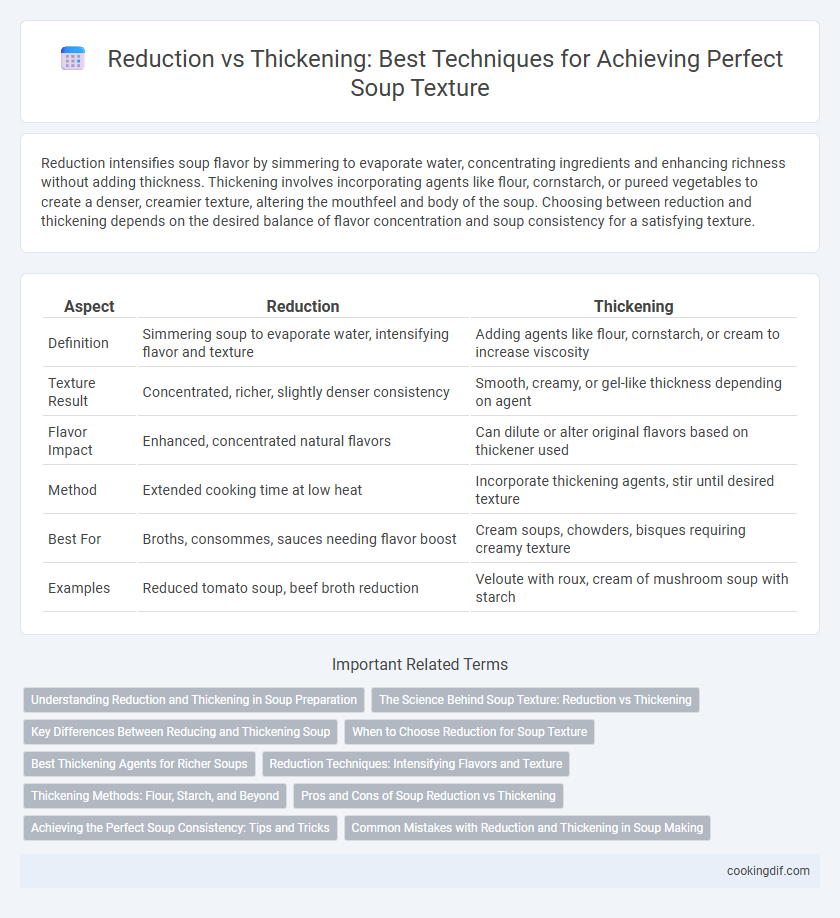Reduction intensifies soup flavor by simmering to evaporate water, concentrating ingredients and enhancing richness without adding thickness. Thickening involves incorporating agents like flour, cornstarch, or pureed vegetables to create a denser, creamier texture, altering the mouthfeel and body of the soup. Choosing between reduction and thickening depends on the desired balance of flavor concentration and soup consistency for a satisfying texture.
Table of Comparison
| Aspect | Reduction | Thickening |
|---|---|---|
| Definition | Simmering soup to evaporate water, intensifying flavor and texture | Adding agents like flour, cornstarch, or cream to increase viscosity |
| Texture Result | Concentrated, richer, slightly denser consistency | Smooth, creamy, or gel-like thickness depending on agent |
| Flavor Impact | Enhanced, concentrated natural flavors | Can dilute or alter original flavors based on thickener used |
| Method | Extended cooking time at low heat | Incorporate thickening agents, stir until desired texture |
| Best For | Broths, consommes, sauces needing flavor boost | Cream soups, chowders, bisques requiring creamy texture |
| Examples | Reduced tomato soup, beef broth reduction | Veloute with roux, cream of mushroom soup with starch |
Understanding Reduction and Thickening in Soup Preparation
Reduction intensifies soup flavor by simmering to evaporate water, concentrating ingredients and enhancing texture without adding thickening agents. Thickening relies on ingredients like flour, cornstarch, or pureed vegetables to increase viscosity, providing a smoother, denser mouthfeel. Mastery of both techniques allows precise control over soup consistency and richness, improving overall sensory experience.
The Science Behind Soup Texture: Reduction vs Thickening
Reduction concentrates flavors and thickens soup by evaporating water, enhancing viscosity through increased solids like proteins and starches. Thickening agents such as roux, cornstarch, or gelatin modify texture by adding body without altering volume, relying on molecular interactions like starch gelatinization or protein coagulation. Understanding the balance between evaporation-induced concentration and additive-induced viscosity is key to achieving desired soup texture and mouthfeel.
Key Differences Between Reducing and Thickening Soup
Reducing soup involves simmering it to evaporate water, concentrating flavors and creating a richer taste without adding extra ingredients. Thickening soup requires incorporating agents such as flour, cornstarch, or pureed vegetables to increase viscosity and create a creamy or smooth texture. Reduction intensifies flavor naturally, while thickening modifies mouthfeel and consistency independently of flavor concentration.
When to Choose Reduction for Soup Texture
Reduction is ideal for enhancing soup texture when a deeper, more concentrated flavor is desired without adding extra ingredients or altering the original recipe balance. This method thickens the soup naturally by simmering and evaporating excess water, resulting in a richer mouthfeel and intensified taste. Opt for reduction when you want to preserve a clear broth while intensifying its essence instead of adding thickening agents like cream or flour.
Best Thickening Agents for Richer Soups
Best thickening agents for richer soups include roux, cornstarch, and cream, each enhancing texture and mouthfeel uniquely. Roux, a mixture of flour and fat, provides a smooth, velvety consistency ideal for chowders and bisques. Cornstarch offers a glossy finish and quick thickening, while cream adds both body and a luxurious richness, perfect for creamy vegetable soups.
Reduction Techniques: Intensifying Flavors and Texture
Reduction techniques concentrate soup by simmering to evaporate water, thereby intensifying flavors and achieving a richer, thicker texture without adding extra ingredients. This process enhances the natural essence of ingredients like vegetables, meats, and spices, resulting in a more concentrated and robust taste profile. Professional chefs often use reduction to balance the soup's consistency while preserving its complexity and depth.
Thickening Methods: Flour, Starch, and Beyond
Thickening soup textures relies on various methods, with flour and starch being the most common agents due to their ability to gelatinize and create a smooth, creamy consistency. Roux, made from flour and fat, offers a rich, velvety texture, while cornstarch or arrowroot provide a translucent finish without affecting flavor. Alternative thickening techniques include pureeing vegetables or legumes, adding cream or yogurt, and utilizing xanthan gum or agar agar for gluten-free, plant-based options.
Pros and Cons of Soup Reduction vs Thickening
Soup reduction intensifies flavor by simmering to evaporate water, resulting in a richer, more concentrated taste but increasing cooking time and risk of over-reduction. Thickening with agents like flour, cornstarch, or cream quickly alters texture without extensive cooking, preserving delicate flavors but potentially masking ingredients or adding unwanted calories. Choosing reduction enhances depth and natural flavor balance, while thickening offers convenience and control over consistency.
Achieving the Perfect Soup Consistency: Tips and Tricks
Achieving the perfect soup consistency requires understanding the difference between reduction and thickening methods. Reduction intensifies flavor and naturally thickens soup by simmering to evaporate excess liquid, ideal for broths and consommes. Thickening involves adding agents like roux, cornstarch, or pureed vegetables to create a rich, creamy texture without altering the soup's original volume.
Common Mistakes with Reduction and Thickening in Soup Making
Over-reducing soup can lead to overly concentrated flavors and a loss of volume, resulting in a dish that is too salty or intense. Thickening with flour or cornstarch often causes a pasty texture if not properly dissolved or added gradually. A common mistake is neglecting to stir continuously during thickening, which can create lumps and uneven consistency.
Reduction vs Thickening for texture Infographic

 cookingdif.com
cookingdif.com